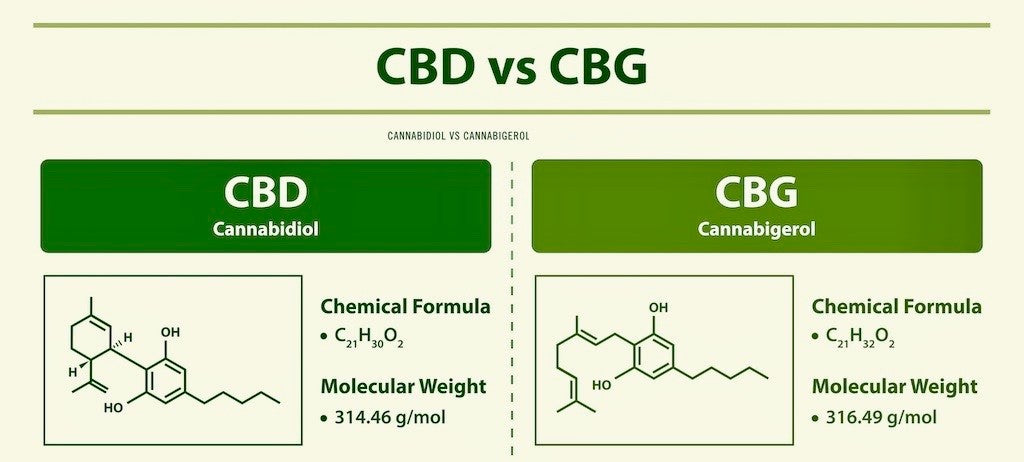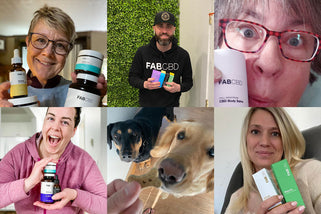
CBD vs CBG: What’s the Difference?
Along with THC and CBD, CBG is also one of the more well-known compounds found in the hemp plant. Even though it might not have been that much of a common name a couple of years ago, CBG is being spoken about and researched more frequently among scientists and consumers as of late. So if you’ve been interested in trying CBD, CBG, or a combination of the two, then you should spend some time getting to know these two cannabinoids.
What are CBD and CBG?

CBD, or cannabidiol, and CBG, or cannabigerol, are two prevalent cannabinoid compounds found in the hemp and marijuana plants, which are both varieties of the cannabis plant. CBG was first discovered in 1964, and since then, scientists have been performing research studies on it to explore its potential positive impacts. Interestingly, cannabinoids occur not only in the cannabis family of plants, but they also naturally exist within the human body. These cannabinoids act as part of the human endocannabinoid system, or ECS, which is responsible for helping to regulate bodily systems like the reproductive system, the nervous system, the immune system, and much more.
Out of the over 100 cannabinoids found in the cannabis plant, CBD is one of the most abundant. It was first discovered in the late 1930s, and then wasn’t looked at again until the 1970s because medical researchers were exploring the possibility of its anticonvulsant properties. Unlike THC, or tetrahydrocannabinol, it does not possess any psychoactive properties. Similarly, CBG is also a non-psychoactive compound, but is only found when the hemp plant blooms. While CBD is more steadily abundant, CBG is only available during the short blooming window of the cannabis plant. Because of this, and since CBG products are just now becoming popular, it may be difficult for consumers to find a strong variety of these types of products in today’s CBD market.
Where do CBD and CBG Come From?

Both CBD and CBG are phytocannabinoids that come from the hemp plant. However, if you’re referring to the human body, then the chemical precursors to these cannabinoids are naturally produced within the body’s endocannabinoid system. CBGA, or cannabigerolic acid, is the precursor to THC and CBD. On its own it does not contain any psychoactive properties. Interestingly, while some of its properties change as it converts over to CBG, others remain unchanged.
While CBD is more commonly known as the multipurpose compound, CBG is called the sister compound of CBD. CBG is known as a precursor to other cannabinoids. So, when CBGA is heated, its acidic form turns into CBG. What’s fascinating is that along with turning into CBG, it also forms CBD, THC, and CBC, or cannabichromene. Even though the research on CBG is limited, what scientists do know is how CBG interacts with the human body. Interestingly, CBD does not interact directly with cannabinoid receptors in the human body. Instead, it mostly interacts with the endocannabinoid system in an indirect fashion. Scientists believe that when you use CBG, however, it directly interacts with the brain’s endocannabinoid system by binding to the CB1 and CB2 cannabinoid receptors.
What Makes CBD and CBG Unique?
Despite the fact that there are lots of promising reports from studies regarding all of the great things that are linked to CBG, some brands are having difficulties producing large quantities of CBG products. The reason for this is that it can take thousands of pounds of cannabis to create very small amounts of CBG isolate. Most hemp plants only contain small percentages of CBG, however, there are newer strains that contain 20 percent or more of CBD. Therefore, if a crop’s CBG content is one percent, you would need to extract 20 times the amount of CBG in hemp just to mirror the amount of CBD that you would get from one crop.
CBG is one of the most expensive cannabinoids to extract from the cannabis plant because of all the hemp that it takes to create just a small amount of CBG extract. When it comes to cultivation, CBG can be problematic. The longer the cannabis plant spends in the soil, the larger the chance that CBGA and CBG will convert to other cannabinoids like CBD, CBC, CBN, and THC. Therefore, farmers have two options: either stick to growing smaller crops of cannabis that have high amounts of CBD, or try growing larger crops of cannabis and harvest it at an earlier stage to gather enough CBG. Additionally, specialized equipment is needed in order to extract CBG. Swiss precision from a chromatography apparatus is used to isolate CBG from other compounds in the hemp plant. And since high-performance chromatography is more expensive than regular chromatography, this can add to the overall cost of the final product.
CBD and CBG are different in many ways. Some of which include:
- Chemical Composition: CBD and CBG have very unique chemical structures. In other words, their hydrogen, carbon, and oxygen atoms are arranged in different formations. So because their chemical structures are shaped differently, they interact with the body’s cannabinoid receptors in a diverse manner. The overall chemical composition can determine how bioavailable the compound is.
- Appetite Effects: Both CBD and CBG can affect the appetite in different ways. In a study conducted on rats, researchers found that while CBG stimulated appetite, CBD dampened it.
- Pharmacology: A study conducted in 2011 that was published in the journal Psychopharmacology discovered that CBD and CBG affected the body’s 5-HT1A serotonin receptor in opposing ways. While CBD is said to activate this receptor, CBG works to block it.
How Do CBG and CBD Work Together?
When CBD and CBG are combined, they end up balancing one another out. CBD helps to stimulate the enzyme that’s responsible for creating the body’s endocannabinoids while CBG directly works on the receptors. People have reported feeling drowsy when they’ve taken CBG alone, and energized when they’ve used CBD by itself. So in thinking about these two opposite reactions, it makes sense then that these two cannabinoids balance each other out when taken together. When CBD and CBG are blended together, it’s usually done in a 1:1 ratio. And the process for taking a CBD+CBG oil is very much the same as you would follow for a CBD oil. Therefore, you should start low and increase your dose slowly over time. Be sure to stick with your dose for about a week before increasing it, and perform regular check-ins with yourself to see how you’re feeling along the way. Additionally, take your oil at the same time(s) each and every day because consistency is key to getting the most out of your CBD+CBG oil combination. Lastly, because everyone’s body is different, there’s not one set dose that will work well for everyone. Be patient and consistent and you will eventually find a dose that works best for your unique body and needs.
What Should You Look for in a CBD and CBG Product?
When searching for a CBD, CBG, or combination product, you should:
- Steer Clear of Cheap Oil — There’s a lot that goes into making high-quality CBD and CBG oils. For example, there’s the cost of the organic farming needed to produce clean hemp, the use of the industry preferred CO2 extraction process to obtain pure and potent extracts, the time that it takes to create the product from seed to sale, the specialized machinery that goes into the growing, harvesting, and extraction processes, and more. All high-quality products that are produced by reputable brands cost more. The old saying, “You get what you pay for,” comes to mind here. Therefore, if a brand is peddling cheaply priced CBD or CBG oil, that should be an immediate red flag for you.
- Read All Third-Party Lab Reports and Certificates of Analysis, or COAs — All reputable brands that make top-notch CBD and/or CBG products use an independent lab to test them. This testing is important because it provides reports on the potency of the CBD/CBG, and the overall cannabinoid profile of the final product. These reports also detail any potential contaminants that may be hiding in the products. Well-known and respected brands post these independent lab reports on their websites and make it easy for customers to find and read them.
- Opt for Full-Spectrum Oils — Full-spectrum oils contain all of the terpenes, phytonutrients, and cannabinoids of the hemp plant, including THC. By federal law, all hemp-based products must contain 0.3% or less THC in order to be bought and sold in the United States. If however, you have concerns about THC or are subjected to regular drug tests, then broad spectrum products are an excellent option. These types of oils contain the same components as full-spectrum oils, except that all of the THC has been filtered out. Finally, CBD or CBG isolate oils contain only 99% pure CBD or CBG, as the other components of the hemp plant have been filtered out using a special process.
Final Thoughts on CBD vs CBG

Even though CBD continues to grow in popularity, CBG is steadily making big gains in the cannabis market. While research on CBG is somewhat limited, scientists are very optimistic about what they have been finding. If you discover that CBG oils are cost prohibitive for you, then you might want to go with a top-quality, full-spectrum CBD oil until some time passes and those prices go down. In searching for a full-spectrum CBD oil, be sure to look for products that were made from hemp strains with a high CBG content. But before you spend any money on any products in general, be sure to read third-party lab reports for those products, and consult with your primary care physician or medical specialist if you have any pressing questions or concerns.

















